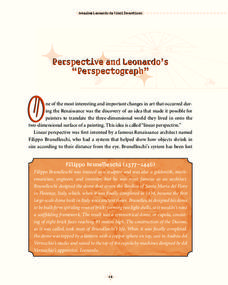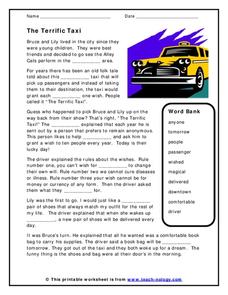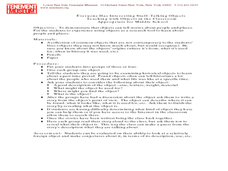The New York Times
Perspective and Leonardo’s “Perspectograph”
Filippo Brunelleschi's invention of linear perspective during the Renaissance was further developed by his apprentice, a young artist named Leonardo da Vinci. Now modern artists can give da Vinci's famous perspectograph a try...
The Alamo
The Alamo
Remember the Alamo! Scholars investigate the Battle of San Jacinto during the Texas Revolution. Using models, maps, quotes, biographies, and the Oath of Allegiance, the Alamo comes to life as the stories of those who fought and died in...
Teach Engineering
Stormy Skies
Young meteorologists examine the four main types of weather fronts and how they appear on a weather map. Participants learn about the difference between the types of weather fronts along with their distinguishing features. A...
Virginia Department of Education
Building a DNA Model
It has been decades since the discovery of DNA. Still, activities such building this DNA model allow blossoming scientists to better understand the components that form this overall structure. During this activity, they will also...
EngageNY
An Appearance of Complex Numbers 1
Complex solutions are not always simple to find. In the fourth lesson of the unit, the class extends their understanding of complex numbers in order to solve and check the solutions to a rational equation presented in the first lesson....
DiscoverE
Siphon Pump
Defy the laws of gravity. A simple activity has learners create a siphon pump for water. The challenge is to get water to flow upwards through a tube.
American Museum of Natural History
What's This? Breathing
Crazy fact: Some animals can survive months without oxygen. An online resource describes some unique ways animals collect oxygen and even live without it for an extended time. Learners read about these special animals and use pop-up...
American Museum of Natural History
Trip Up Your Brain
Sometimes different parts of the brain disagree. See what this disagreement looks like using a remote learning resource to experience how brains often take shortcuts. Pupils complete the activity, observe their results, and then read...
American Museum of Natural History
Tornadoes Spinning Thunderstorms
Tornado winds can reach more than 200 miles per hour. Learners explore wind speeds and more characteristics of tornadoes with an online lesson. They learn how tornadoes form and how scientists attempt to predict them. Can be used as an...
Pingry School
Effect of Solutes on Boiling Point
Anyone that lives around snow knows that adding salts to water increases its melting point. Are there solutes that affect the boiling point as well? A scientific experiment has learners add different solutes to water and then...
Showbie
Student Clicker - Socrative
Ask your class a question, and they can submit their responses in no time. Just like that, their work has been sent to you for review. Try out this super-simple app to increase engagement and inform instruction.
Teach-nology
The Terrific Taxi
What would you wish for if you were granted one wish? Kids read a story about a taxi that bestows wishes upon its passengers in a short cloze activity. They use ten words at the bottom of the page to fill in the blanks throughout the...
K5 Learning
Saving the Birds
Learn about the kindness and strength of Abraham Lincoln with a reading comprehension activity. After third and fourth graders read a short story about Lincoln saving a family of robins, they answer four questions about the plot and...
Mathematics Assessment Project
Sharing Costs Equitably: Traveling to School
Drive or take the school bus? Class members determine the amount each student would have to pay in a carpool situation. They then evaluate the cost in a set of provided examples. I think I'd rather take the school...
Chicago Botanic Garden
Unit 4 Pre-Assessment
Pre-assessments are great to help teachers determine what information their classes lack, what misconceptions they have, and how in depth to teach specific concepts. The first in a five-part series is a pre-assessment of middle...
Curated OER
From Ada to Grace to Sandy - Women Have IT
Explore the significant contributions women have made in the field of information technology with an instructive lesson plan. Through class discussion and research, young scholars discover how women have aided in the growth of the field...
Curated OER
Verbs: Past Participle
In this perfect and past perfect learning exercise, students fill in the blanks with the past participle, and has or have. Students complete 2 activities.
Curated OER
J'ai mal à la tête! (I have a headache!) -- Health Expressions in French
Oh, no! Everyone is getting sick! Young French speakers use French expressions regarding physical health, some of which are idioms. With the use of health expressions provided in the lesson plan, pairs work together to write stories that...
Curated OER
Everyone Has Rules
Students develop awareness of the necessity for rules and use logic to decide what rules make the classroom have a learning and caring atmosphere. They examine the choices they make have consequences.
Curated OER
The Present Is Perfect: Using Present Perfect Tense
Your developing language users rewrite 10 sentences by changing the underlined verbs to present perfect tense verbs with one of the helping verbs: have, has, or had. Resource contains explanatory material as well as a practice worksheet.
Curated OER
Everyone Has Interesting Stuff: Talking Objects Teaching with Objects in the Classroom
What fun! Have your class compose a narrative piece from an object's point of view. They research the object, its origin, and its history, then write their story. Stories can be shared with the class or read to children in a younger grade.
Curated OER
Using Decimal Benchmarks
Students demonstrate some common operations done while using fractions based upon mathematical standards. They are also changing common fractions to decimals with estimation skills and the use of a calculator.
Curated OER
Land Use
Students brainstorm lists of land uses, gather pictures of them, and create a collage. They research land uses in their communities by contacting local agencies. They make charts of the land use planning systems and their impact on...
Curated OER
Use Addition to Subtract
Young scholars practice solving word problems. They subtract one-digit problems, add to check their answers, and attempt to determine which problems have too much information. There are 6 problems to solve.























